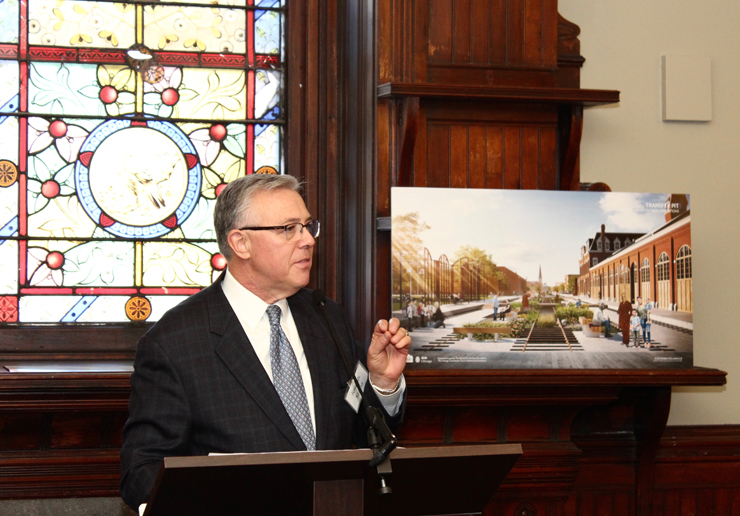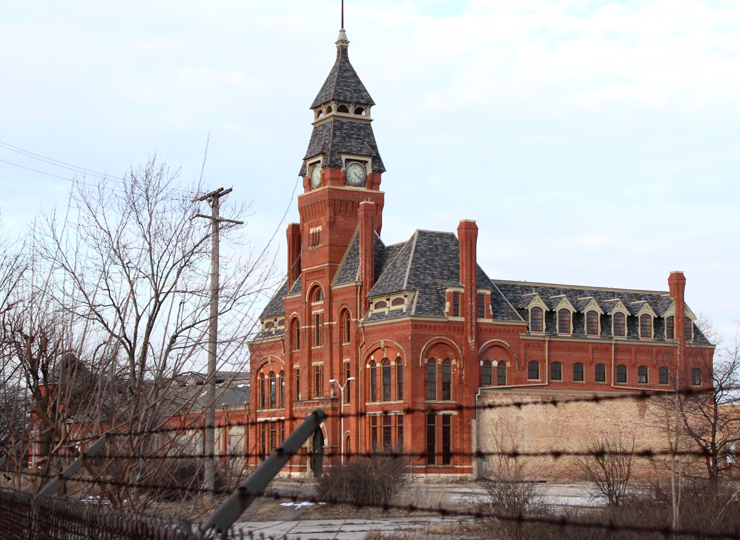CHICAGO — More than $56 million in public and private fundraising begin transforming the Pullman National Monument on Chicago’s South Side. The goal is to create a working replica of the company town that revolutionized passenger railcar manufacturing more than 130 years ago.
Reconstruction of manufacturing facilities are part of plans announced last week at a ceremony commemorating the fifth anniversary of the site’s designation as a national monument by President Barack Obama. Richard Wilson, the architect leading the project for the firm of Adrian Smith + Gordon Gill Architecture, says the plan is to rebuild “a maze of buildings set up like an early conveyor, built along a narrow strip facing a transfer pit.”
The first step calls for opening a Visitors Center in the Romanesque-styled clock tower main building in early 2021. Wilson displayed an artist’s rendering showing how the manufacturing complex would eventually look.
“We lost much of the original character, but we were able to re-establish the transfer pit geometry,” Wilson says. A transfer table straddling the pit moved cars among six tracks leading to specialized bays, where woodwork, electric, and glass installation took place. “With the building reconstruction we will have interpretive signage and demonstrations showing how the factory operated,” he says.
Former Federal Railroad Administrator Joe Szabo recently became president of the Historic Pullman Foundation and will lead fundraising efforts. He once worked as an Illinois Central conductor on what are now Metra Electric trains stopping at the nearby 111th Street station.
Szabo tells Trains News Wire, “The key is to recreate the energy of that transfer pit corridor. It will line up directly with a walk leading from a rebuilt workers gate along 111th Street.” A barbed wire chain-link fence has blocked this entrance for decades.
The foundation, the National Monument’s official “friends” organization, will develop a work plan with the National Park Service around four major themes:
— Transformative railcar production techniques;
— The impact of the 1894 Pullman Strike, recognized as a key moment in U.S. labor law;
— Life in the nation’s first planned industrial community, whose row houses today remain part of an increasingly vibrant Chicago residential neighborhood;
— The origins of A. Phillip Randolph’s Brotherhood of Sleeping Car Porters, the first African American labor union.
“The Pullman Foundation is expected to give input, help fund, and prioritize daily programming that elaborates on these four elements,” Szabo says. “This will include tours of two recently acquired residences. “He also hopes hopes to draw visitors someday by including Pullman-built railcars beyond the mock-up of an 1890s-era sleeping car planned for the Visitors Center opening next spring.
Szabo and Metra Chairman Norm Carlson are seeking a possible three-way partnership with the Illinois Railway Museum, which has a pair of 1926 Illinois Central multiple unit electric commuter cars constructed at the Pullman plant. Those sent to the museum after toiling in revenue service for over 50 years.
“My dream,” Szabo says, “would be to use the ex-IC electrics on weekend excursions between downtown Chicago and Pullman.” He quickly admits, “That would be a real stretch because some of their components are close to 100 years old and no longer available.”
The museum also has other Pullman equipment that could make periodic appearances, but lack of direct rail access from a nearby Chicago Rail Link industrial spur would complicate creation of an on-site exhibit with revolving displays. That ground-level spur once served the sprawling facility when operated by the Rock Island.
Szabo stresses discussions among all parties are very preliminary, but there would be potential cross-promotion possibilities if funding is secured and mutually beneficial agreements can be reached.
















This site had had a serious fire sometime in the 1990’s. I had seen Pullman in 1982; in 2005 I rode by on an IC (new) train (OK, METRA) and seen the ruins which I thought had included the building shown so maybe they’ve done some rebuilding. In 1982 I took a picture of the Pullman Methodist Church and its sign at a streetcorner–the Coach Methodist Church was at the block’s other end, I envisioned myself saying at a slide show. Another feature I saw in Pullman was the Hotel Florence named after Pullman’s daughter; wonder how that is doing?
“…REBUILDING…” Its’ use seems to indicate some level of re-construction (?) :or possibly recreating some of the P-S car types(?) . As the wording in the song indicates “… Woulden’t it be loverly…!” 🙂
Believe all original Superliners where built at Pullmans Hammond Indiana plant. My neighbor worked there right to the very last car.
Also, the main building is not Romanesque, but rather a mash-up of Beaux-Arts and high-Victorian fru-fraw.
Interesting idea but don’t walk more than 2 blocks west of Pullman past the Metra Electric (West Pullman) after dark. The odds of losing a valuable increase with each block you walk. Also if you are white and are walking or driving west down 115th after dark, a CPD officer will ask you what the blazes you are doing here and they won’t be nice about it.
Very good story, and hope it turns into a article from beginning, post closing and future with pictures and statistics. PS thank you for fixing the spelling of my name.
MICHAEL KLASS – This site has everything you’d want. A residential area whose restoration (one house at a time) is well underway, the hoped-for restoration of the factory (story above) and two adjacent stops on the Metra Electric. Worth a visit now, and in the hoped-for future much more to see.
Sounds ambitious, but you gotta start somewhere.
Sounds like a great plan and it’s in the right hands.
One might comment on the arts & crafts stained glass window in the pix, assuming it’s in the main building, which if so indicates a decent level of preservation and a good harbinger for future use.
Now way off topic…there have been discussions on the relative merits of Budd domes vs. PS designs. Pouring gas on that fire..years of Hiawatha Super Dome rides, Chicago-Columbus or MSP and reverse in the 1960’s and a last one in 1970 found them excellent. Ditto North Coast Ltd. to Seattle in 1962 and 1970. The former more spacious, the latter more intimate.
It was a century ago when the first all-steel passenger cars were constructed on this site. They became known as ‘heavyweight’ cars because of weight comparison to the lighter stainless steel passenger cars constructed from the 1930s on. Since the lightweight cars defied conventions of car materials and construction, the heavyweight cars were also called ‘standard’ cars for a while until it became clear they will never be built agakn.
This is the birthplace of the first railway car I boarded and rode. It was a 14-4 (14 roomette 4 double bedroom) Pullman sleeping car on Missouri Pacific’s flagship ‘Texas Eagle’ out of Houston. Because of my tiny stature at 8 months old, a roomette was sufficient for me and my mother. I vaguely remember being surrounded by painted metal walls and ceiling while seated on a cushion by the window. So, my first train trip was in a Pullman-Standard sleeping car.
Pullman-Standard became my favourite railway carmaker.
ANDREW – By then the original Superliners will be on the way to retirement. They were built here.
The actual Pullman cars presence would lend much needed context to this project. You do not need rail access. Much easier to transport by flatbed truck, as the antique equipment would not need to be approved for interchange and rail shipment.
While not the Pullman cars he would like to run. Build replicas of the IC cars. It would be cheaper in the long run..
Charles, I have to agree with you mostly this time, but do need to make the correction that it’s a reconstruction of the manufacturing facility(which does not currently exist as it was torn down years ago). So a combination of restoration and reconstructing old facilities.